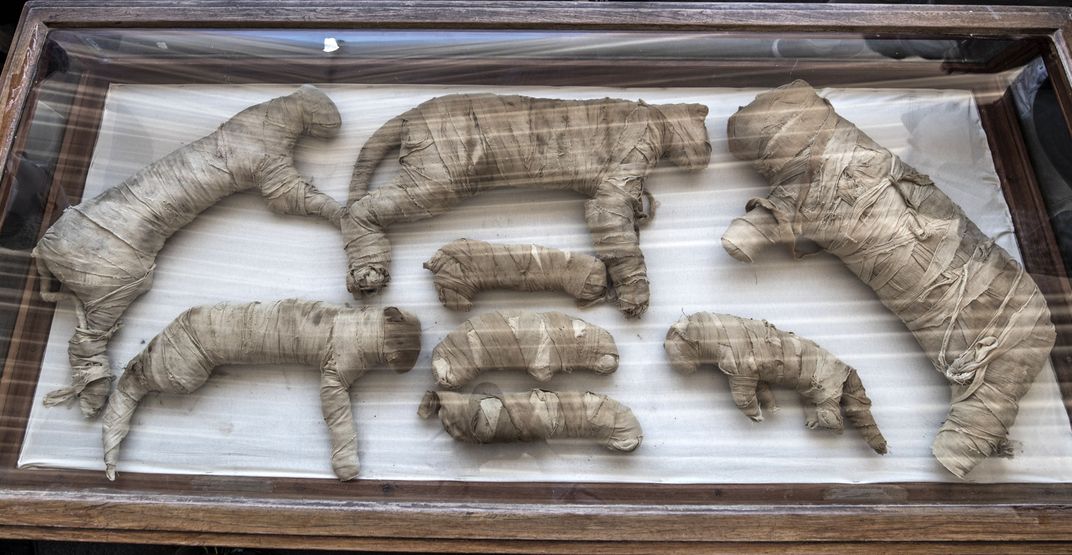Archaeologists Reveal Rare Mummified Lion Cubs Unearthed in Egypt
CT scans identified two of five mummified big cats as young lions, but the remaining animals’ identities remain unclear
/https://tf-cmsv2-smithsonianmag-media.s3.amazonaws.com/filer/85/27/85271bf8-2e8f-44e9-a587-5ba7f9afc734/gettyimages-1184126848.jpg)
Over the weekend, the Egyptian Antiquities Ministry unveiled a huge cache of ancient artifacts and mummified animals—most significantly, the rare remains of at least two lion cubs—discovered in Saqqara, a necropolis located just south of Cairo.
According to a statement posted on the ministry’s Facebook page, the trove includes 75 wooden and bronze statues of cats; 25 decorated wooden boxes filled with mummified cats; and statues of animals and birds ranging from bulls to a mongoose, an ibis and a falcon. Crocodiles, cobras and scarab beetles are among the other mummified creatures found at the site. Archaeologists also uncovered a large stone scarab and two smaller wood and sandstone depictions of the sacred beetle.
Egypt’s antiquities minister, Khaled El-Enany, says the finds could fill “a museum by itself.”
Additional discoveries detailed in the statement are 73 bronze statues of the god Osiris, 6 wooden statues of the god Ptah-Soker, 11 statues of the lioness goddess Sekhmet and a carved statue of the goddess Neith. The cache also holds amulets, mummy masks and papyrus scrolls covered in drawings of the goddess Tawert. An item containing the name King Psamtik I dates many of the items to the 26th dynasty, which ruled Egypt between 610 and 664 B.C.

The archaeologists’ most important find was a set of five mummified cats. CT scans identified two of the animals as lion cubs based on the size and shape of their bones, but the remaining three cats have yet to be definitively identified.
At a press conference held Saturday, Mostafa Waziri, general secretary of Egypt's Supreme Council of Antiquities, said the team’s hoard marked “the first time [the] complete mummy of a lion or lion cub” has been found in Egypt. Per Live Science’s Owen Jarus, the lions’ demure stature suggests they were not fully grown at the time of their death.
As Ruth Michaelson reports for the Guardian, the team plans on scanning the trio of still-unidentified felines to gain a better sense of the animals’ origins.
“If it’s a cheetah, a leopard, a lioness, a panther—whatever, it will be one of its kind,” says Waziri, as quoted by Michaelson.
The lion cubs are not the first of their species to be found in the area. French archaeologists unearthed part of the skeleton of an adult lion at Saqqara in 2004, revealing what the Associated Press’ Samy Magdy describes as the “sacred status of the animal in ancient times.”

Speaking with Michaelson, Salima Ikram, an Egyptologist at the American University of Cairo, says, “I think it’s one of the most exciting series of finds in the world of animal mummies ever.”
She adds, “People would make devotional offerings in the form of animals as mummies. This would have more potency as a blood sacrifice, compared to stone or wooden images.”
The practice was so popular in ancient Egypt that a bonfafide industry centered on ritualized animal sacrifice soon emerged. Millions of cats and dogs were bred specifically for ritual mummification; meanwhile, the sacred ibis, another species mummified by the millions, may have been lured from the wild rather than bred in large-scale hatcheries.
“The list is really long, you can name most of the animals and birds known to ancient Egyptians as getting mummified at one stage,” Sally Wasef, a researcher from Australia’s Griffith University who led a recent study on ibis mummies, told Newsweek’s Aristos Georgiou earlier this month. “Some were pets and in the same time gods like cats, dogs, falcons, monkeys. Some were just god’s incarnations on earth like snakes, crocodiles, cows, etc.”
The lion cubs aren’t the only significant finds to come out of Saqqara recently. Late last year, archaeologists uncovered the 4,400-year-old untouched tomb of a man named Wahtye. As A.R. Williams reported for National Geographic at the time, hieroglyphs carved above the tomb’s entrance identified Wahtye as a “royal purification priest, royal supervisor, and inspector of the sacred boat.” Other discoveries include a beautifully decorated catacomb dating to roughly 2,000 years ago and a 2,500-year-old silver face mask gilded with gold.